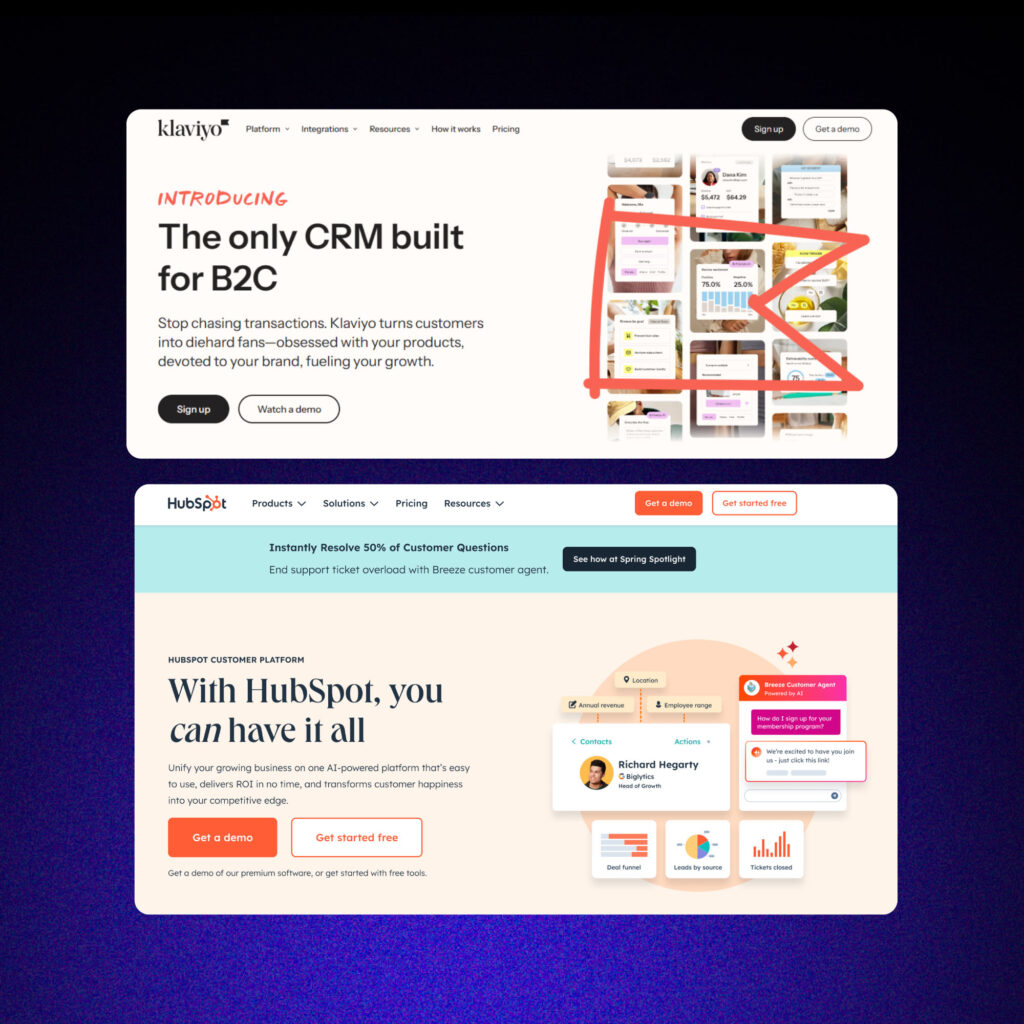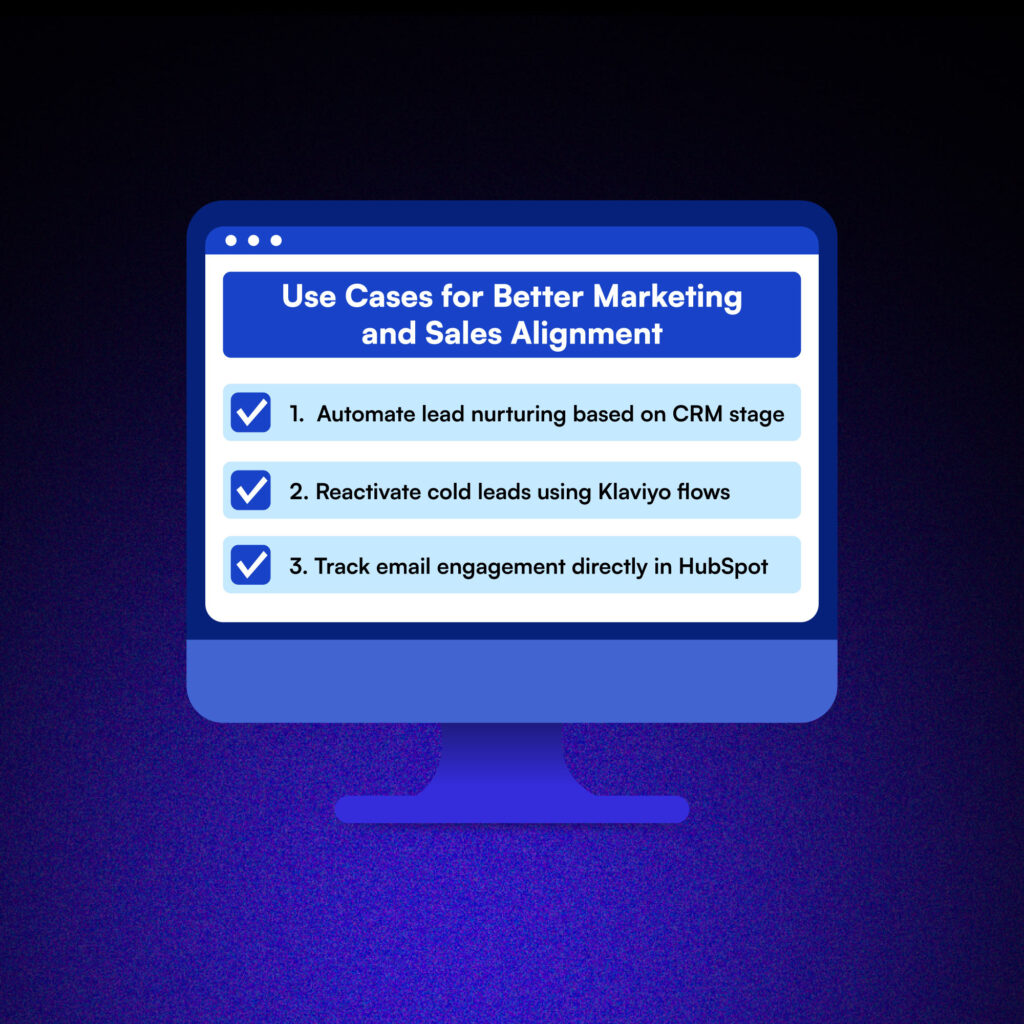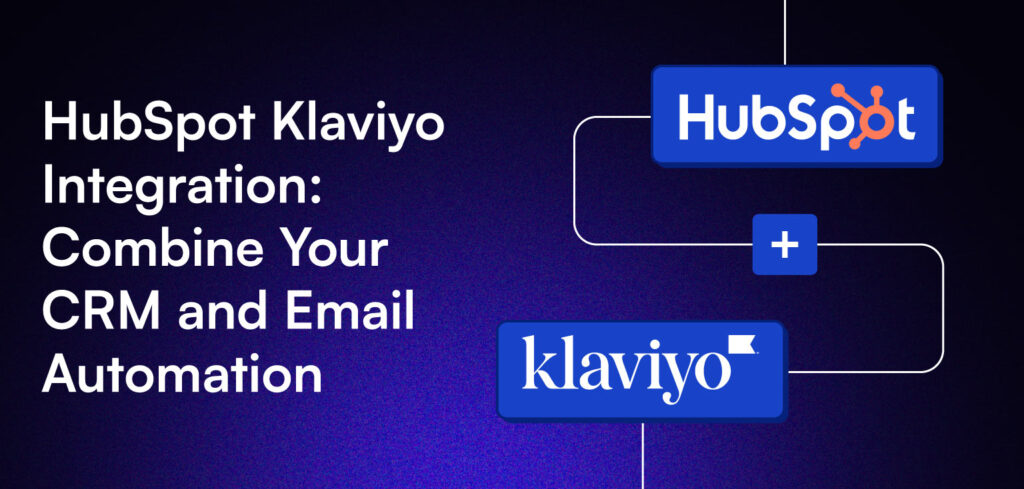Why Connect HubSpot with Klaviyo?

- Shared intelligence between platforms: HubSpot updates flow into Klaviyo, and Klaviyo’s email activity syncs right back to your CRM. You get visibility into every interaction, from lifecycle stages to purchase behavior all in one place.
- Smarter email timing: Trigger flows in Klaviyo based on real HubSpot events—like form fills, deal updates, or contact lifecycle changes. No more guessing when to reach out or relying on stale segments.
- Real-time syncing, no manual effort: Say goodbye to CSV uploads. Contacts and activity data stay in sync across both platforms automatically, so your emails always reflect the latest customer actions.
- Stronger sales and marketing alignment: Sales teams get insight into email engagement inside HubSpot. Marketing gets access to CRM details in Klaviyo. That means more relevant emails, fewer dropped leads, and better campaign performance across the board.
What You Can Do with Hubspot Klaviyo integration
1. Sync Contacts And Lifecycle Stages
2. Trigger Klaviyo Flows Based On Hubspot Events
Actions in HubSpot, like a form fill, meeting booked, or deal stage change, can trigger emails or SMS messages in Klaviyo. This lets you automate timely follow-ups based on real activity, not just assumptions.
A new deal booked?
Send a personalized thank-you series. A lead hits “Sales Qualified”? Start a nurture campaign that speaks to where they are.
3. Use Klaviyo Data To Guide Sales Follow-Ups
The integration works both ways. Klaviyo engagement data, opens, clicks, and purchase history can sync into HubSpot so your sales team knows who’s active. Reps can prioritize the hottest leads without guessing.
It’s like giving sales a highlight reel of who’s really interested.
Pro tip: Create a HubSpot custom field that marks contacts as “Highly Engaged” once they’ve clicked multiple Klaviyo emails. Then, build tasks or alerts for your sales team to follow up faster.
How to Set Up the HubSpot Klaviyo Integration
Getting HubSpot and Klaviyo to work together is easier than most people think, and the payoff is huge. Once connected, you’ll start seeing tighter workflows, better-timed emails, and smarter segmentation that reflects what’s happening in your CRM.
1. Step-by-step setup overview
Start by logging into Klaviyo. Under “Integrations,” search for HubSpot and click “Add Integration.” You’ll be prompted to log into your HubSpot account and authorize access.
After that, you can choose which lists and fields to sync. It only takes a few minutes to connect everything.
2. What data syncs and how often
Klaviyo pulls in HubSpot contact properties, including email, first and last name, lifecycle stage, and any custom fields you map. The sync is near real-time, meaning changes made in HubSpot will reflect in Klaviyo almost instantly – no waiting around for nightly updates.
You can also configure Klaviyo to send back key engagement data like opens, clicks, and order history into HubSpot, giving your sales team more insight for follow-ups.
3. Things to check before going live
Before you flip the switch, double-check that your fields are mapped correctly. Make sure custom properties (like MQL status or product interest) are aligned, and test the flow with a dummy contact to see how the sync behaves. You’ll also want to segment your lists properly in Klaviyo to avoid sending duplicate or misfired campaigns.
Pro tip: Tag synced contacts with a “source” property in both platforms. That way, you can segment them more cleanly and avoid muddying your existing workflows.
Use Cases for Better Marketing and Sales Alignment

Once Hubspot Klaviyo integration is running, it’s time to put it to work. The goal is a more aligned, more responsive funnel from lead to close.
Here are three practical ways to use it:
1. Automate Lead Nurturing Based On Crm Stage
When a contact moves from “Lead” to “MQL” in HubSpot, Klaviyo can kick off an automated nurture sequence tailored to that lifecycle stage. Instead of generic emails, they’ll get content that matches their readiness to buy, like case studies, FAQs, or product comparison guides.
This keeps leads warm without overwhelming your sales team with manual check-ins.
2. Reactivate Cold Leads Using Klaviyo Flows
Have leads in HubSpot that went cold? Don’t let them sit idle.
Use Klaviyo to create reactivation flows triggered by a deal going stale or a contact becoming inactive. These emails can reintroduce offers, showcase new features, or simply ask, “Still interested?”
It’s a low-effort way to revive conversations without relying on sales alone.
3. Track Email Engagement Directly In Hubspot
Your sales reps shouldn’t have to guess who’s paying attention. With Klaviyo activity like email opens, clicks, or product views fed into HubSpot, they can prioritize leads based on actual interest. That makes follow-ups feel more relevant and timely.
Pro tip: Build filtered HubSpot views that sort leads by Klaviyo activity. For example, “Contacts who clicked in the last 7 days.” That alone can save your team hours.
Wrapping Up
The HubSpot Klaviyo integration is a serious upgrade for teams that want smarter marketing and smoother handoffs.
When your CRM and email automation tools are in sync, everything becomes more efficient: no missed leads, no duplicate efforts, and no data silos. At its best, this integration helps you run faster campaigns, tailor messaging based on real-time behavior, and empower your sales team with actual insights, not guesswork.
It’s not about choosing one tool over the other. It’s about making both work together to create a seamless customer experience.
And the best part?
You don’t need to overhaul your entire process. Start small, sync smart, and scale as you go. The results will speak for themselves.


